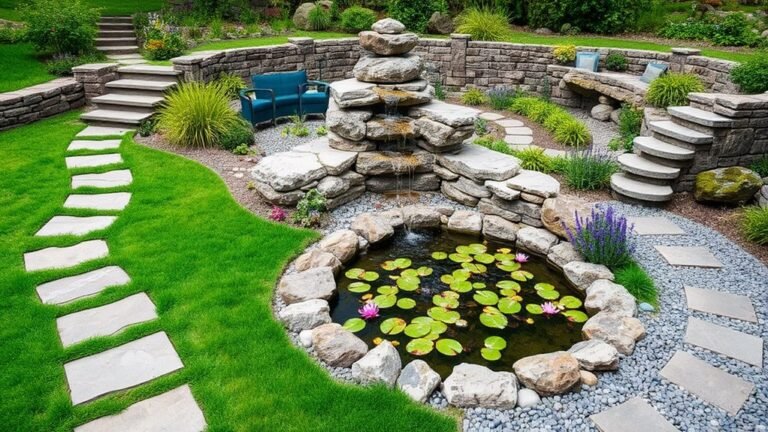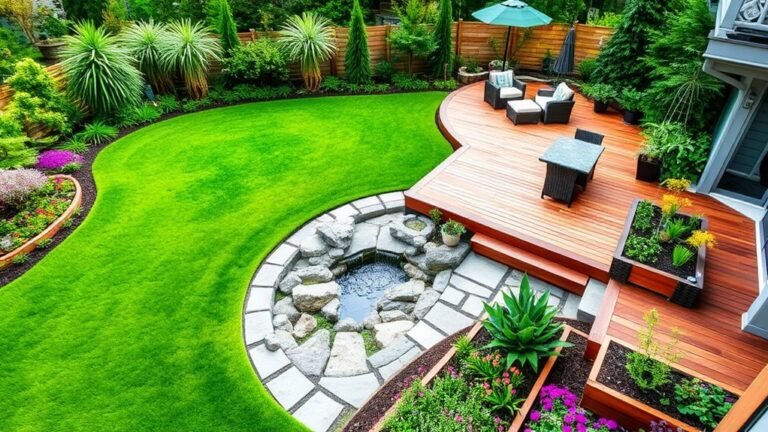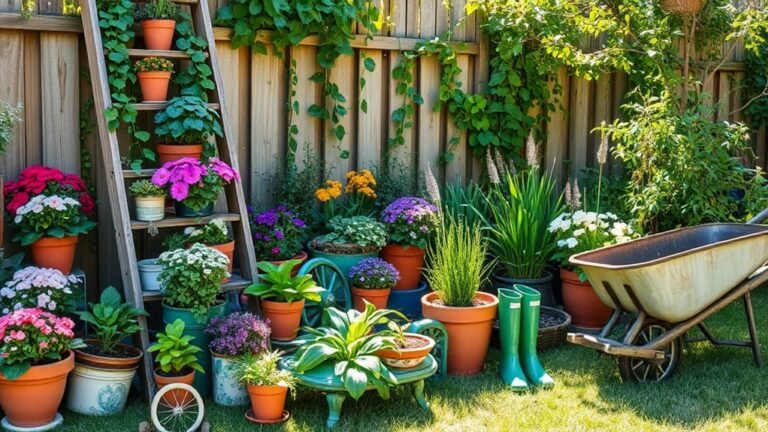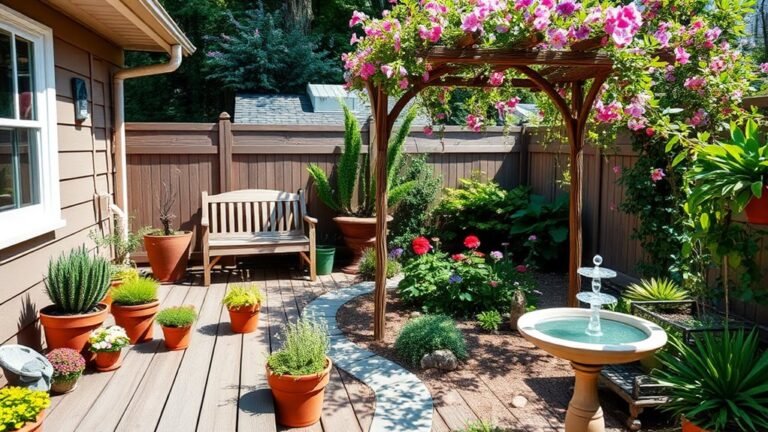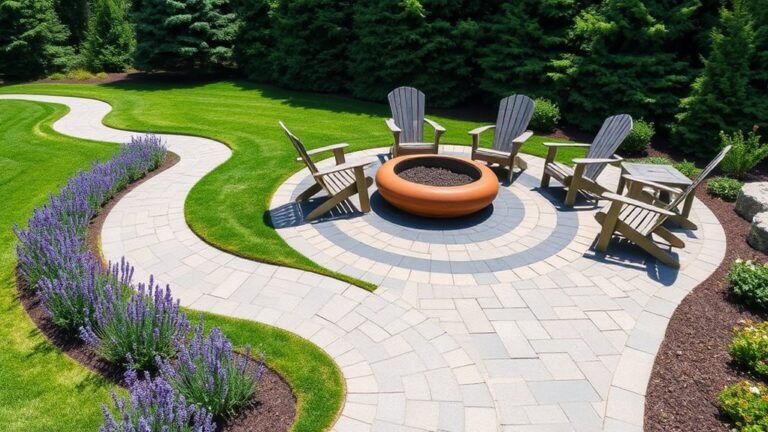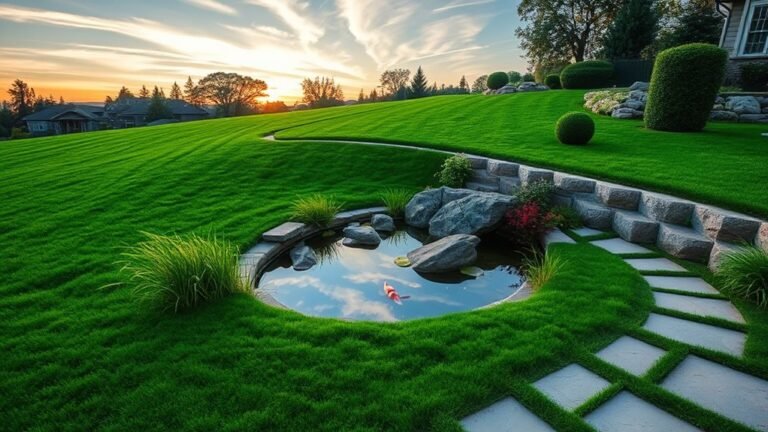22 Backyard Food Garden Ideas for Fresh Produce

Transform your backyard into a vibrant grocery store filled with fresh produce ready for harvest. Discover creative strategies for maximizing space, from vertical gardening to innovative container designs.
Learn sustainable practices that ensure a continuous harvest throughout the year, all while keeping your costs low. With these ideas, you can cultivate a thriving garden without overspending.
Vertical Gardening Solutions

Maximize your backyard space by embracing vertical gardening solutions! Instead of wasting limited ground space, think upwards with trellises, wall planters, and hanging pots to create a lush green oasis.
Picture tomatoes climbing a sturdy trellis and vibrant cucumbers cascading from above. This approach not only saves space but also enhances your garden's visual appeal. You can even repurpose old pallets or ladders into unique vertical garden displays, allowing your plants to shine while reflecting your style.
Additionally, vertical gardening makes plant maintenance easier, as it reduces the need for bending, alleviating back strain.
Plus, it's much more enjoyable to garden without the need to crouch down to reach those stubborn weeds!
Container Gardening Tips

Limited space doesn't mean limited gardening opportunities; container gardening can turn small patios or balconies into lush green areas.
With creativity, you can grow everything from herbs to tomatoes, perfect for fresh meals.
Begin with choosing pots that have drainage holes to avoid soggy roots.
Use a quality potting mix for optimal drainage and nutrients.
Larger containers retain more soil and moisture, benefiting your plants.
Select a sunny location, as most vegetables thrive in direct sunlight.
If your space lacks sun, leafy greens can flourish in partial shade.
Regular watering is essential, as containers dry out faster than garden beds.
Be sure to fertilize every few weeks for optimal growth.
Most importantly, have fun!
Combine different shapes, colors, and plant varieties for a vibrant display.
You'll create not just food but a lively oasis in your space.
Happy gardening!
Raised Bed Gardens
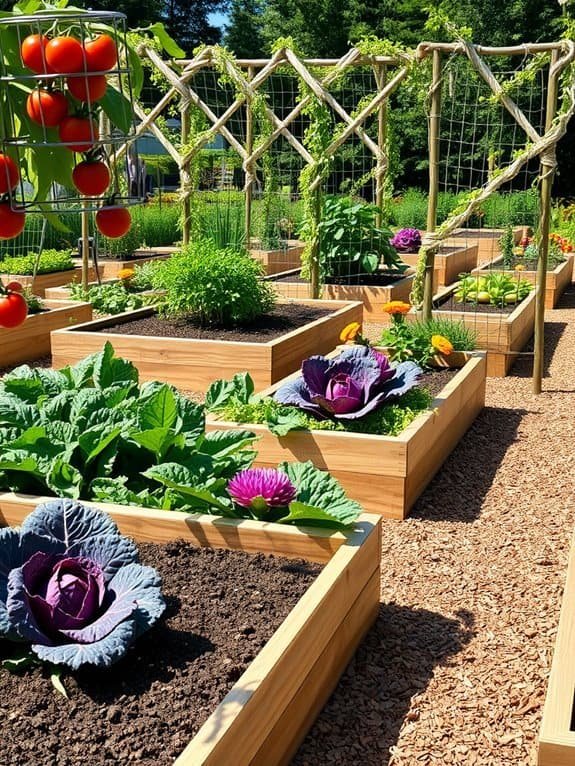
To maximize your gardening potential, raised bed gardens are an excellent choice—elevated, stylish, and productive!
By defining a space for your plants, you can control soil quality, drainage, and reduce weeds.
Building a raised bed is simple; use materials like wood, stone, or repurposed bricks, ensuring it's at least 12 inches deep for root development.
Fill it with rich, well-draining soil, perfect for growing carrots, tomatoes, and peppers.
Raised beds also alleviate back strain since everything is easily accessible.
You can further manage pests by framing your beds with netting or barriers.
Herb Spiral Designs

Raised bed gardens provide structure and innovative designs like herb spirals. These charming three-dimensional gardens maximize space and add whimsy to your backyard, featuring a vibrant array of herbs like basil, thyme, and rosemary.
Building an herb spiral is simple: choose a sunny location and gather stones or bricks to form a spiral. Stacking the materials creates various height levels, enabling each herb to thrive in its ideal microclimate—drier and sunnier at the top, moister and cooler at the bottom.
Plant your favorite cooking herbs and enjoy their fragrant scents and fresh produce for delightful meals. Herb spirals not only serve a practical purpose but also spark conversations among friends, making them a joyful addition to your culinary garden!
Community Garden Involvement

Getting involved in a community garden can enhance your gardening skills and deepen your connections with neighbors and nature.
Picture yourself digging in the soil alongside fellow gardening enthusiasts, sharing tips and laughs over vegetable mishaps. You'll learn from experienced gardeners while exchanging ideas and building camaraderie.
As you plant and care for your crops together, you'll forge connections with your neighbors that you mightn't have otherwise.
Plus, there's immense satisfaction in sharing the literal fruits of your labor, bringing home fresh produce and fun stories for the local potluck.
Community gardens are inclusive spaces where everyone's contributions are valued, so even if you're new to gardening, you'll feel welcome.
You may also discover new skills, such as composting or canning, all while enjoying the fresh air and sunshine.
Pollinator-Friendly Planting

When creating a vibrant backyard food garden, incorporate pollinator-friendly plants to attract bees, butterflies, and other beneficial insects. These creatures not only help your garden flourish but also bring life and color.
Select a variety of blooms that flower at different times throughout the growing season to provide a continuous buffet for pollinators from spring to fall. Consider lavender, echinacea, and sunflowers for their beauty and delightful fragrance.
Design your garden layout with patches of these pollinator magnets, allowing insects to move freely.
Avoid pesticides, as they can harm your winged friends, and instead, encourage friendly bugs that assist with pest control.
DIY Garden Trellises

Trellises can enhance your backyard food garden by adding vertical interest and support for climbing plants. They not only improve the garden's appearance but also maximize space and allow veggies to flourish.
Building a DIY trellis is easy with materials like wood, bamboo stakes, or old ladders—no advanced carpentry skills needed.
Begin by choosing a sunny spot, measuring your desired dimensions, and gathering your materials. Small cedar boards work well, but you can also repurpose materials. Firmly set the posts in the ground for stability, and attach horizontal slats or strings to create the framework.
Now you have a beautiful trellis!
Plant climbing beans, cucumbers, or peas to watch them ascend, transforming your garden into a lush masterpiece. Climbing plants often yield more produce and thrive off the ground.
Companionship Planting Ideas

Creating a productive backyard food garden involves strategic companion planting.
For example, plant tomatoes with basil to enhance flavor and repel whiteflies.
Pair corn with beans, as beans can climb the corn while adding nitrogen to the soil.
Additionally, nasturtiums attract aphids away from vegetables and add color to the garden.
Planting carrots near onions can help confuse carrot pests due to the onion's strong scent.
Square Foot Gardening

Square foot gardening is an efficient approach that maximizes space and simplifies vegetable cultivation. Transform a small patch of dirt in your backyard into a productive garden by organizing your plants in a grid layout. This method allows you to grow various vegetables without overcrowding while creating a thriving mini-ecosystem.
Here's how to start:
- Create a Frame: Build a 4×4 foot frame using wood or sturdy material to define your garden area.
- Divide the Space: Mark off one-foot squares inside the frame with string or a ruler, making it easy to manage each tiny garden plot.
- Plant Wisely: Fill each square with different crops—herbs, vegetables, or flowers—mixing them for a vibrant and diverse garden.
With square foot gardening, you'll maximize yield easily and enjoy an adorable garden that brings joy as you care for your plants.
Happy gardening!
Edible Landscaping Techniques

Edible landscaping combines beauty with functionality by integrating food-producing plants into your yard. Imagine plucking ripe tomatoes or fragrant herbs as you admire colorful blooms—your garden becomes both visually stunning and delectable!
Start by mixing vegetables with ornamental plants; for example, plant marigolds around your veggie patch to enhance aesthetics and deter pests.
Consider vertical gardening with trellises or hanging baskets to save space while adding visual appeal, like fresh strawberries cascading down.
Account for seasonal changes by planting perennials such as asparagus or rhubarb for annual yields.
Group plants with similar needs to simplify watering. By adding edible elements to your landscape, your garden transforms into a source of fresh food, ensuring it's as delightful as your dinner plate!
Indoor Vegetable Gardens

An indoor vegetable garden can enhance your living space, allowing you to enjoy fresh herbs or cherry tomatoes straight from your countertop.
Even a windowsill can accommodate a thriving garden.
To succeed, focus on these three elements:
- Light: Ensure adequate sunlight, ideally from a south-facing window, or use grow lights on cloudy days.
- Containers: Select pots with good drainage; consider repurposing jars or tin cans for a creative touch.
- Soil: Use a nutrient-rich potting mix for optimal plant health.
With a little effort, you can relish the joy of growing your own food indoors, providing you with great conversation starters at dinner parties.
Happy gardening!
Hydroponic Systems

Hydroponic systems provide a modern method for growing plants without soil, making them an appealing choice for backyard gardens.
Imagine vibrant greens thriving in nutrient-rich water, eliminating weeds and muddy shoes!
There are several hydroponic setups, such as deep water culture and nutrient film technique. Each has unique features, but all nourish plants without dirt.
These systems are perfect for limited space or sunlight, allowing for fresh produce without a large garden – a definite win!
Moreover, watching your plants flourish is exciting.
With just a bit of care, you'll be harvesting herbs and tomatoes, feeling like a gardening magician running your own mini-farm.
Perennial Vegetable Choices
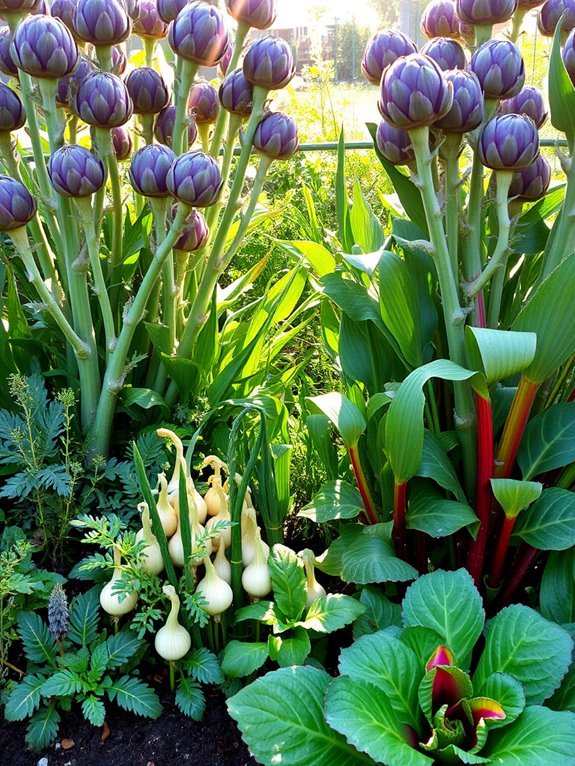
For a sustainable backyard garden, consider adding perennial vegetables that return year after year, providing fresh produce without replanting each spring.
Here are three top choices:
- Asparagus – It may take a couple of years to establish, but once rooted, you can harvest spears for over 20 years, perfect for a variety of dishes.
- Rhubarb – Known for its tart flavor and striking leaves, rhubarb enhances your garden with a zesty kick, even though you'll need sugar for pie.
- Jerusalem Artichokes – These nutty tubers thrive in various soils and can spark interesting conversations in your veggie garden.
Incorporating these perennial vegetables not only provides delicious harvests but also eases your gardening efforts.
That's a win-win!
Fruit Tree Options

When planning your backyard food garden, consider planting fruit trees that will beautify your space and yield delicious harvests. Imagine picking fresh apples or peaches right outside your door! In addition to fruit trees, be sure to incorporate a variety of vegetables to create a thriving ecosystem. For those new to this rewarding endeavor, there are valuable backyard vegetable gardening tips available online that can help you maximize your space and produce. From companion planting to seasonal harvesting, these strategies will ensure that your garden flourishes with fresh produce all year round.
When selecting fruit trees, consider your climate, available space, and personal preferences. Dwarf varieties are ideal for smaller spaces, providing the same tasty fruits in a compact form.
Apple and cherry trees are reliable choices for many regions, while citrus trees like lemon and tangerine thrive in warmer climates. For a unique twist, try fig or persimmon trees—your friends will be impressed!
Planting multiple types can extend your harvest season. Remember, fruit trees require regular care, including pruning and consistent watering, especially during dry spells.
With a little attention, your backyard can transform into a fruitful paradise, making gardening an enjoyable adventure!
Salad Box Gardens

After enjoying the fruits of your trees, why not elevate your meals with fresh greens?
Salad box gardens are a charming and practical way to add vibrant veggies to your backyard, even in small spaces. With a little creativity, you can create unique small vegetable garden designs that can thrive in limited areas. Consider using vertical planters or repurposed containers to maximize your growing space while keeping things visually appealing. These gardens not only provide fresh produce but also bring a touch of greenery to your outdoor environment.
Consider the types of greens you'd love to have on hand. Here are three essentials for your box garden:
- Lettuce – Crisp and perfect for any salad base.
- Spinach – Nutrient-rich, adding depth to mixes.
- Radishes – Crunchy and zesty, enhancing flavor.
Building your salad box is simple! Ensure good drainage by elevating your soil, and you'll enjoy the pleasure of harvesting fresh greens.
There's nothing like it! So get started and let your salad box garden thrive—your taste buds will appreciate it!
Gardening With Kids

Involving kids in gardening can turn a simple backyard into an adventure of learning and discovery. Their excitement as they dig, plant seeds, and watch for sprouts is priceless!
Start with easy-to-grow plants like radishes or sunflowers and assign each child a garden section. Let them choose plants to teach responsibility and decision-making. A little mess is part of the fun!
As they care for their plants, they'll learn the patience required for growth—a valuable life lesson. Celebrate every sprout and bloom, regardless of imperfections.
Don't be surprised if you hear "Is it ready yet?" countless times! Include harvesting in the experience and cook together with their produce. This fosters appreciation for their efforts and a love for fresh, homegrown food.
Who knew gardening could be so enjoyable?
Organic Pest Control

When pesky insects invade your garden plants, organic pest control methods can keep your garden thriving without harmful chemicals. Instead of using store-bought sprays that might drive away both bugs and friends, try these effective strategies:
- Natural Predators: Attract beneficial insects like ladybugs and lacewings, which will feast on aphids, protecting your plants.
- DIY Sprays: Create a simple homemade spray using crushed garlic or neem oil mixed with water. This will deter pests while giving your plants an odd smell.
- Companion Planting: Grow marigolds, nasturtiums, or basil alongside your vegetables. These plants help repel unwanted pests while enhancing your garden's beauty.
Zone-Specific Planting

Understanding your USDA Hardiness Zone is crucial for successful zone-specific planting, as it guides you in selecting plants that thrive in your local climate.
For example, you wouldn't plant tropical fruits in the Arctic, right? By knowing your zone, you can choose the right vegetables or herbs that will flourish in your garden.
In warmer zones like 9 or 10, consider planting tomatoes, peppers, or sweet potatoes, which thrive in the sunshine.
In cooler zones like 5 or 6, focus on hardy crops like kale or carrots that can withstand colder temperatures.
Timing is equally important! Planting schedules differ based on your zone, so be mindful of your frost dates to protect your plants from frost damage.
By considering your USDA Zone, you're not just growing food—you're creating a vibrant ecosystem in your backyard.
Greenhouse Benefits

A backyard garden is fulfilling, but a greenhouse elevates your gardening experience.
Picture a warm, sunlit space brimming with vibrant plants, allowing you to grow your favorite vegetables year-round.
Here are three key benefits of having a greenhouse:
- Extended Growing Season: Start planting earlier in spring and continue harvesting into fall. Take charge against Mother Nature!
- Pest and Weather Protection: Safeguard your plants from harsh weather and pests, eliminating worries about hail damage or rabbits eating your tomatoes.
- Controlled Environment: Manage temperature, humidity, and light, providing ideal conditions for plants—a true spa experience!
Rainwater Harvesting

Rainwater harvesting can significantly enhance your backyard gardening. By collecting rainwater, you not only reduce your water bill but also provide your garden with a natural, chemical-free water source.
Getting started is simple—just place a rain barrel under your downspout and let nature do its work. Your plants will thrive on this soft, low-salt water, which is perfect for both seedlings and established plants.
Watering your tomatoes with rainwater isn't only effective but also adds to your gardening experience.
Rainwater is the secret ingredient to a flourishing garden, so grab your rain barrel and enjoy the benefits!
Seasonal Succession Planting

Seasonal succession planting boosts your garden's productivity year-round by rotating and replanting crops as seasons change, ensuring you're always harvesting fresh produce.
Think of it like a relay race, with each plant taking its turn.
Consider these three crops:
- Spring Greens: Start with quick-growing spinach or lettuce that thrive in cooler weather.
- Summer Crops: Transition to heat-loving veggies like tomatoes or peppers for the warm months.
- Fall Favorites: As summer crops finish, plant hardy varieties like kale or beets to continue production into autumn.
Gardening on a Budget

Maximizing your garden's output on a budget is possible without sacrificing quality or variety.
Start by reusing containers like old buckets, jars, or shoe organizers as mini-gardens.
Instead of buying young plants, opt for seeds, which are usually cheaper and can produce more. You'll feel like a gardening magician when those sprouts appear!
Create compost from kitchen scraps for free fertilizer, turning veggie peels into garden nourishment.
Join local gardening groups or community exchanges to swap seeds or seedlings, expanding your garden at no cost.
Frequently Asked Questions
What Are the Best Vegetables for Beginners to Grow?
If you're diving into gardening, you'll want to start with some easy vegetables!
Think about growing lettuce, radishes, or beans—they sprout fast and are super forgiving.
Carrots are another great choice, just don't forget to loosen the soil.
You'll be amazed at how quickly you can see your hard work paying off!
Plus, who doesn't love fresh veggies in their salads?
Get ready, your green thumb is about to come alive!
How Do I Choose the Right Location for My Garden?
Choosing the right location for your garden is like picking the perfect spot for a picnic.
You'll want plenty of sunlight, so look for an area getting at least six hours a day. Avoid spots that collect water or have too much shade, since plants don't love that.
And, if your neighbor's big dog sees your veggies as a buffet, it might be wise to keep your garden fenced in.
Happy planting!
When Is the Best Time to Plant Different Crops?
You know what they say, "April showers bring May flowers!"
For planting crops, timing's everything. Generally, you wanna plant cool-season crops like lettuce and peas in early spring, while warm-season crops like tomatoes and peppers thrive in late spring after the frost.
Keep an eye on your local frost dates, so your plants don't get a rude awakening!
Get ready to dig in, and you'll have a bountiful garden in no time!
How Can I Attract Beneficial Insects to My Garden?
You can attract beneficial insects to your garden in a few fun ways!
Start by planting flowers like marigolds or daisies; these beauties bring in pollinators.
Don't forget to provide a little shelter with native plants or shrubs—this gives bugs a cozy home.
You could also skip the pesticides; they scare off helpful critters.
Finally, add a small shallow dish of water, and watch as your garden buzzes with life!
Enjoy the show!
What Tools Are Essential for Successful Home Gardening?
Think of your garden as a blank canvas, and the right tools are your trusty paintbrushes!
You'll need a quality shovel, trowel, and hoe to dig in. A sturdy rake helps clear debris, while pruners keep plants tidy.
Don't forget gloves to protect your hands; they're your armor! A watering can or garden hose is essential, too.
With these tools, you'll turn your gardening aspirations into a vibrant masterpiece of fresh produce!
Conclusion
Here are 22 foolproof backyard food garden ideas to help you become a gardening rock star!
From towering tomatoes to spiral herbs, you'll soon have your own mini farm.
Imagine the fresh produce ready for your next feast!
With a little creativity and enthusiasm, your backyard can outshine even the fanciest restaurant.
Happy gardening!

